EU Law's Supremacy: Legal Framework, Doctrines, and Implications
VerifiedAdded on 2020/05/16
|5
|1950
|84
Essay
AI Summary
This essay examines the concept of EU law supremacy, its legal framework, and its implications for member states. It begins by defining regional integration and the EU's supra-constitutional legal system, highlighting the roles of key institutions like the Commission, Council, Parliament, and the Court of Justice (ECJ). The essay explores the doctrines of direct effect and supremacy, emphasizing the ECJ's role in establishing these principles and the EU's sui generis legal system, which combines elements of Common Law and Civil Law. It also discusses the Lisbon Treaty's impact on the EU's external actions and the conflicts between national and international rules. The essay concludes by examining the impact of EU law on national administrations and judges, emphasizing the primacy of EU law and the acceptance of the transfer of powers by member states. References from legal scholars are included to support the analysis.
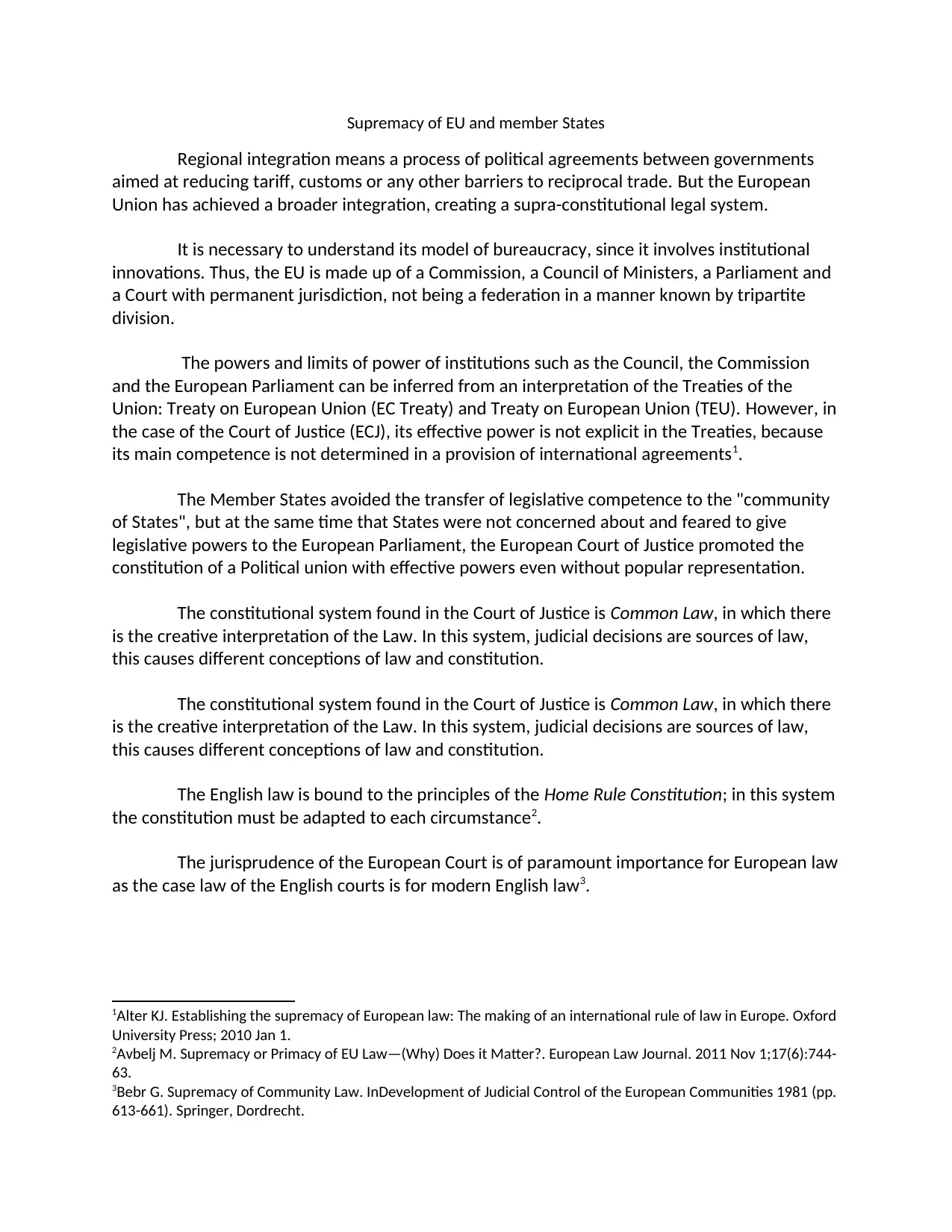
Supremacy of EU and member States
Regional integration means a process of political agreements between governments
aimed at reducing tariff, customs or any other barriers to reciprocal trade. But the European
Union has achieved a broader integration, creating a supra-constitutional legal system.
It is necessary to understand its model of bureaucracy, since it involves institutional
innovations. Thus, the EU is made up of a Commission, a Council of Ministers, a Parliament and
a Court with permanent jurisdiction, not being a federation in a manner known by tripartite
division.
The powers and limits of power of institutions such as the Council, the Commission
and the European Parliament can be inferred from an interpretation of the Treaties of the
Union: Treaty on European Union (EC Treaty) and Treaty on European Union (TEU). However, in
the case of the Court of Justice (ECJ), its effective power is not explicit in the Treaties, because
its main competence is not determined in a provision of international agreements1.
The Member States avoided the transfer of legislative competence to the "community
of States", but at the same time that States were not concerned about and feared to give
legislative powers to the European Parliament, the European Court of Justice promoted the
constitution of a Political union with effective powers even without popular representation.
The constitutional system found in the Court of Justice is Common Law, in which there
is the creative interpretation of the Law. In this system, judicial decisions are sources of law,
this causes different conceptions of law and constitution.
The constitutional system found in the Court of Justice is Common Law, in which there
is the creative interpretation of the Law. In this system, judicial decisions are sources of law,
this causes different conceptions of law and constitution.
The English law is bound to the principles of the Home Rule Constitution; in this system
the constitution must be adapted to each circumstance2.
The jurisprudence of the European Court is of paramount importance for European law
as the case law of the English courts is for modern English law3.
1Alter KJ. Establishing the supremacy of European law: The making of an international rule of law in Europe. Oxford
University Press; 2010 Jan 1.
2Avbelj M. Supremacy or Primacy of EU Law—(Why) Does it Matter?. European Law Journal. 2011 Nov 1;17(6):744-
63.
3Bebr G. Supremacy of Community Law. InDevelopment of Judicial Control of the European Communities 1981 (pp.
613-661). Springer, Dordrecht.
Regional integration means a process of political agreements between governments
aimed at reducing tariff, customs or any other barriers to reciprocal trade. But the European
Union has achieved a broader integration, creating a supra-constitutional legal system.
It is necessary to understand its model of bureaucracy, since it involves institutional
innovations. Thus, the EU is made up of a Commission, a Council of Ministers, a Parliament and
a Court with permanent jurisdiction, not being a federation in a manner known by tripartite
division.
The powers and limits of power of institutions such as the Council, the Commission
and the European Parliament can be inferred from an interpretation of the Treaties of the
Union: Treaty on European Union (EC Treaty) and Treaty on European Union (TEU). However, in
the case of the Court of Justice (ECJ), its effective power is not explicit in the Treaties, because
its main competence is not determined in a provision of international agreements1.
The Member States avoided the transfer of legislative competence to the "community
of States", but at the same time that States were not concerned about and feared to give
legislative powers to the European Parliament, the European Court of Justice promoted the
constitution of a Political union with effective powers even without popular representation.
The constitutional system found in the Court of Justice is Common Law, in which there
is the creative interpretation of the Law. In this system, judicial decisions are sources of law,
this causes different conceptions of law and constitution.
The constitutional system found in the Court of Justice is Common Law, in which there
is the creative interpretation of the Law. In this system, judicial decisions are sources of law,
this causes different conceptions of law and constitution.
The English law is bound to the principles of the Home Rule Constitution; in this system
the constitution must be adapted to each circumstance2.
The jurisprudence of the European Court is of paramount importance for European law
as the case law of the English courts is for modern English law3.
1Alter KJ. Establishing the supremacy of European law: The making of an international rule of law in Europe. Oxford
University Press; 2010 Jan 1.
2Avbelj M. Supremacy or Primacy of EU Law—(Why) Does it Matter?. European Law Journal. 2011 Nov 1;17(6):744-
63.
3Bebr G. Supremacy of Community Law. InDevelopment of Judicial Control of the European Communities 1981 (pp.
613-661). Springer, Dordrecht.
Paraphrase This Document
Need a fresh take? Get an instant paraphrase of this document with our AI Paraphraser
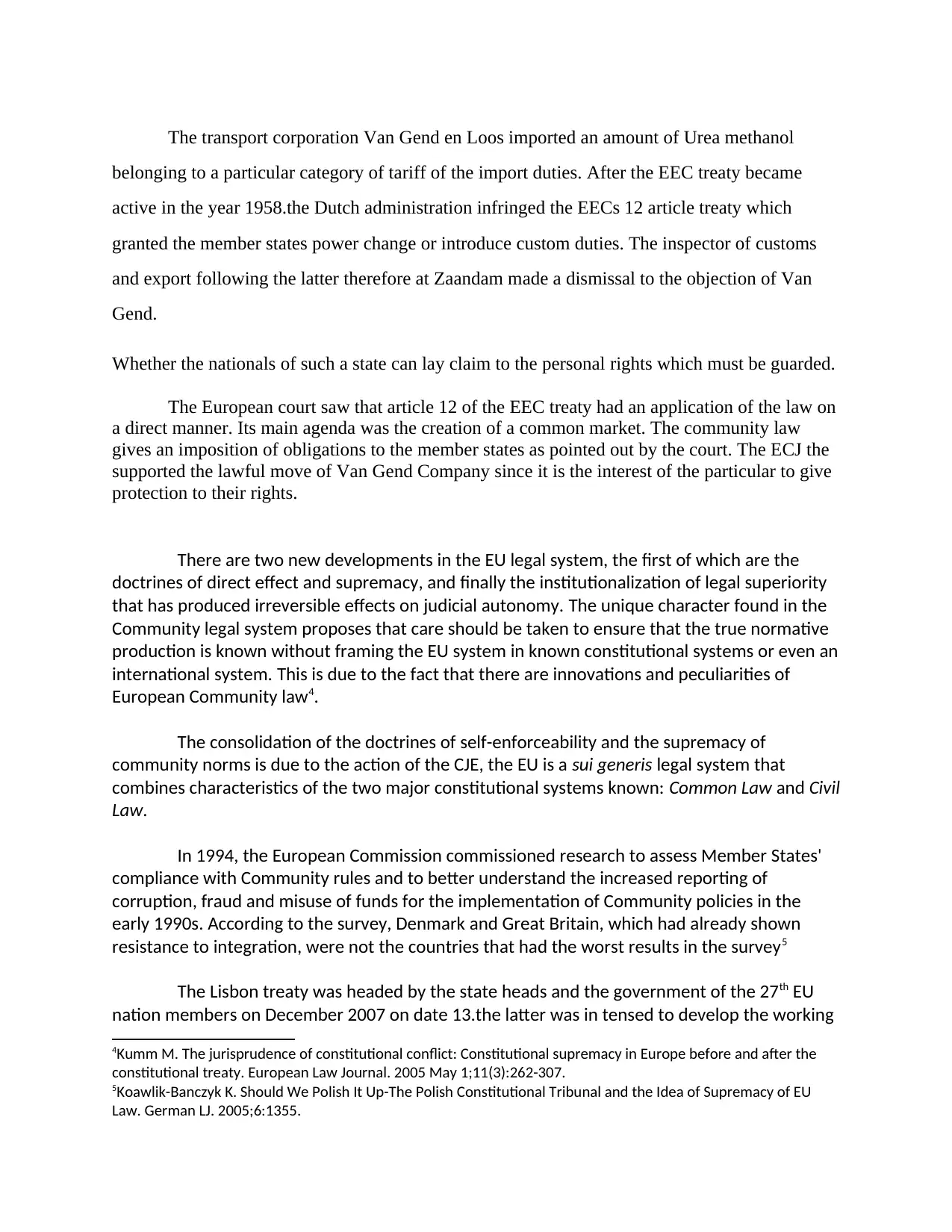
The transport corporation Van Gend en Loos imported an amount of Urea methanol
belonging to a particular category of tariff of the import duties. After the EEC treaty became
active in the year 1958.the Dutch administration infringed the EECs 12 article treaty which
granted the member states power change or introduce custom duties. The inspector of customs
and export following the latter therefore at Zaandam made a dismissal to the objection of Van
Gend.
Whether the nationals of such a state can lay claim to the personal rights which must be guarded.
The European court saw that article 12 of the EEC treaty had an application of the law on
a direct manner. Its main agenda was the creation of a common market. The community law
gives an imposition of obligations to the member states as pointed out by the court. The ECJ the
supported the lawful move of Van Gend Company since it is the interest of the particular to give
protection to their rights.
There are two new developments in the EU legal system, the first of which are the
doctrines of direct effect and supremacy, and finally the institutionalization of legal superiority
that has produced irreversible effects on judicial autonomy. The unique character found in the
Community legal system proposes that care should be taken to ensure that the true normative
production is known without framing the EU system in known constitutional systems or even an
international system. This is due to the fact that there are innovations and peculiarities of
European Community law4.
The consolidation of the doctrines of self-enforceability and the supremacy of
community norms is due to the action of the CJE, the EU is a sui generis legal system that
combines characteristics of the two major constitutional systems known: Common Law and Civil
Law.
In 1994, the European Commission commissioned research to assess Member States'
compliance with Community rules and to better understand the increased reporting of
corruption, fraud and misuse of funds for the implementation of Community policies in the
early 1990s. According to the survey, Denmark and Great Britain, which had already shown
resistance to integration, were not the countries that had the worst results in the survey5
The Lisbon treaty was headed by the state heads and the government of the 27th EU
nation members on December 2007 on date 13.the latter was in tensed to develop the working
4Kumm M. The jurisprudence of constitutional conflict: Constitutional supremacy in Europe before and after the
constitutional treaty. European Law Journal. 2005 May 1;11(3):262-307.
5Koawlik-Banczyk K. Should We Polish It Up-The Polish Constitutional Tribunal and the Idea of Supremacy of EU
Law. German LJ. 2005;6:1355.
belonging to a particular category of tariff of the import duties. After the EEC treaty became
active in the year 1958.the Dutch administration infringed the EECs 12 article treaty which
granted the member states power change or introduce custom duties. The inspector of customs
and export following the latter therefore at Zaandam made a dismissal to the objection of Van
Gend.
Whether the nationals of such a state can lay claim to the personal rights which must be guarded.
The European court saw that article 12 of the EEC treaty had an application of the law on
a direct manner. Its main agenda was the creation of a common market. The community law
gives an imposition of obligations to the member states as pointed out by the court. The ECJ the
supported the lawful move of Van Gend Company since it is the interest of the particular to give
protection to their rights.
There are two new developments in the EU legal system, the first of which are the
doctrines of direct effect and supremacy, and finally the institutionalization of legal superiority
that has produced irreversible effects on judicial autonomy. The unique character found in the
Community legal system proposes that care should be taken to ensure that the true normative
production is known without framing the EU system in known constitutional systems or even an
international system. This is due to the fact that there are innovations and peculiarities of
European Community law4.
The consolidation of the doctrines of self-enforceability and the supremacy of
community norms is due to the action of the CJE, the EU is a sui generis legal system that
combines characteristics of the two major constitutional systems known: Common Law and Civil
Law.
In 1994, the European Commission commissioned research to assess Member States'
compliance with Community rules and to better understand the increased reporting of
corruption, fraud and misuse of funds for the implementation of Community policies in the
early 1990s. According to the survey, Denmark and Great Britain, which had already shown
resistance to integration, were not the countries that had the worst results in the survey5
The Lisbon treaty was headed by the state heads and the government of the 27th EU
nation members on December 2007 on date 13.the latter was in tensed to develop the working
4Kumm M. The jurisprudence of constitutional conflict: Constitutional supremacy in Europe before and after the
constitutional treaty. European Law Journal. 2005 May 1;11(3):262-307.
5Koawlik-Banczyk K. Should We Polish It Up-The Polish Constitutional Tribunal and the Idea of Supremacy of EU
Law. German LJ. 2005;6:1355.
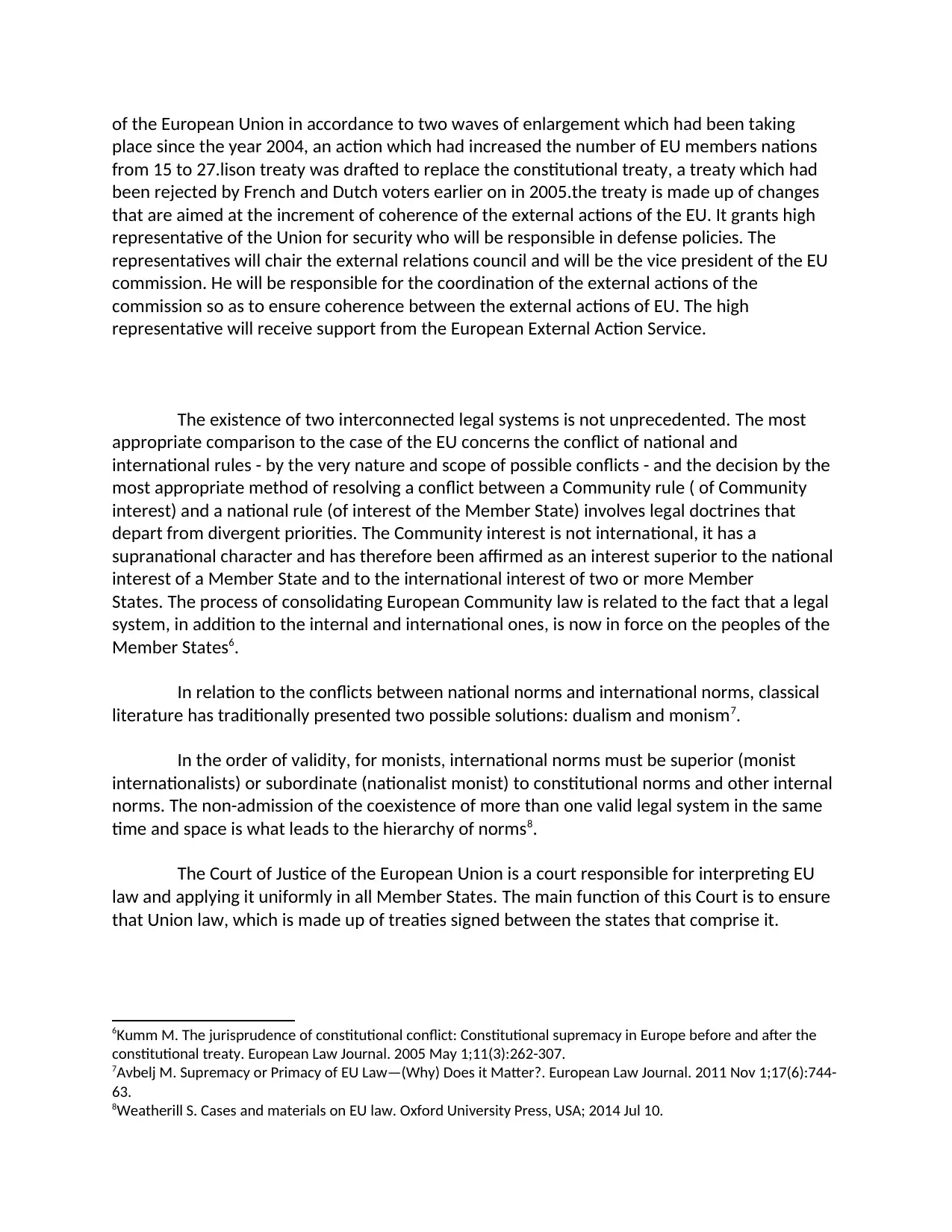
of the European Union in accordance to two waves of enlargement which had been taking
place since the year 2004, an action which had increased the number of EU members nations
from 15 to 27.lison treaty was drafted to replace the constitutional treaty, a treaty which had
been rejected by French and Dutch voters earlier on in 2005.the treaty is made up of changes
that are aimed at the increment of coherence of the external actions of the EU. It grants high
representative of the Union for security who will be responsible in defense policies. The
representatives will chair the external relations council and will be the vice president of the EU
commission. He will be responsible for the coordination of the external actions of the
commission so as to ensure coherence between the external actions of EU. The high
representative will receive support from the European External Action Service.
The existence of two interconnected legal systems is not unprecedented. The most
appropriate comparison to the case of the EU concerns the conflict of national and
international rules - by the very nature and scope of possible conflicts - and the decision by the
most appropriate method of resolving a conflict between a Community rule ( of Community
interest) and a national rule (of interest of the Member State) involves legal doctrines that
depart from divergent priorities. The Community interest is not international, it has a
supranational character and has therefore been affirmed as an interest superior to the national
interest of a Member State and to the international interest of two or more Member
States. The process of consolidating European Community law is related to the fact that a legal
system, in addition to the internal and international ones, is now in force on the peoples of the
Member States6.
In relation to the conflicts between national norms and international norms, classical
literature has traditionally presented two possible solutions: dualism and monism7.
In the order of validity, for monists, international norms must be superior (monist
internationalists) or subordinate (nationalist monist) to constitutional norms and other internal
norms. The non-admission of the coexistence of more than one valid legal system in the same
time and space is what leads to the hierarchy of norms8.
The Court of Justice of the European Union is a court responsible for interpreting EU
law and applying it uniformly in all Member States. The main function of this Court is to ensure
that Union law, which is made up of treaties signed between the states that comprise it.
6Kumm M. The jurisprudence of constitutional conflict: Constitutional supremacy in Europe before and after the
constitutional treaty. European Law Journal. 2005 May 1;11(3):262-307.
7Avbelj M. Supremacy or Primacy of EU Law—(Why) Does it Matter?. European Law Journal. 2011 Nov 1;17(6):744-
63.
8Weatherill S. Cases and materials on EU law. Oxford University Press, USA; 2014 Jul 10.
place since the year 2004, an action which had increased the number of EU members nations
from 15 to 27.lison treaty was drafted to replace the constitutional treaty, a treaty which had
been rejected by French and Dutch voters earlier on in 2005.the treaty is made up of changes
that are aimed at the increment of coherence of the external actions of the EU. It grants high
representative of the Union for security who will be responsible in defense policies. The
representatives will chair the external relations council and will be the vice president of the EU
commission. He will be responsible for the coordination of the external actions of the
commission so as to ensure coherence between the external actions of EU. The high
representative will receive support from the European External Action Service.
The existence of two interconnected legal systems is not unprecedented. The most
appropriate comparison to the case of the EU concerns the conflict of national and
international rules - by the very nature and scope of possible conflicts - and the decision by the
most appropriate method of resolving a conflict between a Community rule ( of Community
interest) and a national rule (of interest of the Member State) involves legal doctrines that
depart from divergent priorities. The Community interest is not international, it has a
supranational character and has therefore been affirmed as an interest superior to the national
interest of a Member State and to the international interest of two or more Member
States. The process of consolidating European Community law is related to the fact that a legal
system, in addition to the internal and international ones, is now in force on the peoples of the
Member States6.
In relation to the conflicts between national norms and international norms, classical
literature has traditionally presented two possible solutions: dualism and monism7.
In the order of validity, for monists, international norms must be superior (monist
internationalists) or subordinate (nationalist monist) to constitutional norms and other internal
norms. The non-admission of the coexistence of more than one valid legal system in the same
time and space is what leads to the hierarchy of norms8.
The Court of Justice of the European Union is a court responsible for interpreting EU
law and applying it uniformly in all Member States. The main function of this Court is to ensure
that Union law, which is made up of treaties signed between the states that comprise it.
6Kumm M. The jurisprudence of constitutional conflict: Constitutional supremacy in Europe before and after the
constitutional treaty. European Law Journal. 2005 May 1;11(3):262-307.
7Avbelj M. Supremacy or Primacy of EU Law—(Why) Does it Matter?. European Law Journal. 2011 Nov 1;17(6):744-
63.
8Weatherill S. Cases and materials on EU law. Oxford University Press, USA; 2014 Jul 10.
⊘ This is a preview!⊘
Do you want full access?
Subscribe today to unlock all pages.

Trusted by 1+ million students worldwide
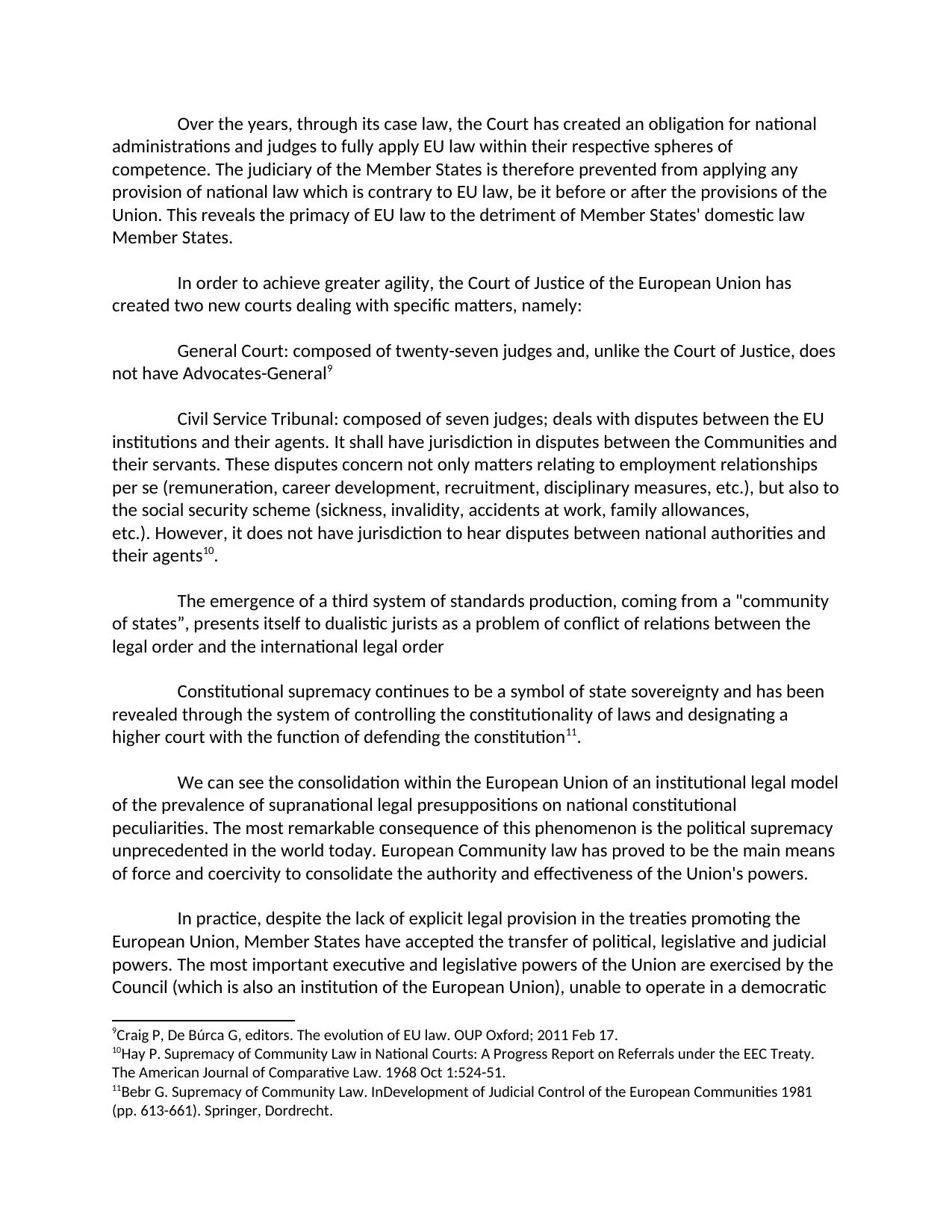
Over the years, through its case law, the Court has created an obligation for national
administrations and judges to fully apply EU law within their respective spheres of
competence. The judiciary of the Member States is therefore prevented from applying any
provision of national law which is contrary to EU law, be it before or after the provisions of the
Union. This reveals the primacy of EU law to the detriment of Member States' domestic law
Member States.
In order to achieve greater agility, the Court of Justice of the European Union has
created two new courts dealing with specific matters, namely:
General Court: composed of twenty-seven judges and, unlike the Court of Justice, does
not have Advocates-General9
Civil Service Tribunal: composed of seven judges; deals with disputes between the EU
institutions and their agents. It shall have jurisdiction in disputes between the Communities and
their servants. These disputes concern not only matters relating to employment relationships
per se (remuneration, career development, recruitment, disciplinary measures, etc.), but also to
the social security scheme (sickness, invalidity, accidents at work, family allowances,
etc.). However, it does not have jurisdiction to hear disputes between national authorities and
their agents10.
The emergence of a third system of standards production, coming from a "community
of states”, presents itself to dualistic jurists as a problem of conflict of relations between the
legal order and the international legal order
Constitutional supremacy continues to be a symbol of state sovereignty and has been
revealed through the system of controlling the constitutionality of laws and designating a
higher court with the function of defending the constitution11.
We can see the consolidation within the European Union of an institutional legal model
of the prevalence of supranational legal presuppositions on national constitutional
peculiarities. The most remarkable consequence of this phenomenon is the political supremacy
unprecedented in the world today. European Community law has proved to be the main means
of force and coercivity to consolidate the authority and effectiveness of the Union's powers.
In practice, despite the lack of explicit legal provision in the treaties promoting the
European Union, Member States have accepted the transfer of political, legislative and judicial
powers. The most important executive and legislative powers of the Union are exercised by the
Council (which is also an institution of the European Union), unable to operate in a democratic
9Craig P, De Búrca G, editors. The evolution of EU law. OUP Oxford; 2011 Feb 17.
10Hay P. Supremacy of Community Law in National Courts: A Progress Report on Referrals under the EEC Treaty.
The American Journal of Comparative Law. 1968 Oct 1:524-51.
11Bebr G. Supremacy of Community Law. InDevelopment of Judicial Control of the European Communities 1981
(pp. 613-661). Springer, Dordrecht.
administrations and judges to fully apply EU law within their respective spheres of
competence. The judiciary of the Member States is therefore prevented from applying any
provision of national law which is contrary to EU law, be it before or after the provisions of the
Union. This reveals the primacy of EU law to the detriment of Member States' domestic law
Member States.
In order to achieve greater agility, the Court of Justice of the European Union has
created two new courts dealing with specific matters, namely:
General Court: composed of twenty-seven judges and, unlike the Court of Justice, does
not have Advocates-General9
Civil Service Tribunal: composed of seven judges; deals with disputes between the EU
institutions and their agents. It shall have jurisdiction in disputes between the Communities and
their servants. These disputes concern not only matters relating to employment relationships
per se (remuneration, career development, recruitment, disciplinary measures, etc.), but also to
the social security scheme (sickness, invalidity, accidents at work, family allowances,
etc.). However, it does not have jurisdiction to hear disputes between national authorities and
their agents10.
The emergence of a third system of standards production, coming from a "community
of states”, presents itself to dualistic jurists as a problem of conflict of relations between the
legal order and the international legal order
Constitutional supremacy continues to be a symbol of state sovereignty and has been
revealed through the system of controlling the constitutionality of laws and designating a
higher court with the function of defending the constitution11.
We can see the consolidation within the European Union of an institutional legal model
of the prevalence of supranational legal presuppositions on national constitutional
peculiarities. The most remarkable consequence of this phenomenon is the political supremacy
unprecedented in the world today. European Community law has proved to be the main means
of force and coercivity to consolidate the authority and effectiveness of the Union's powers.
In practice, despite the lack of explicit legal provision in the treaties promoting the
European Union, Member States have accepted the transfer of political, legislative and judicial
powers. The most important executive and legislative powers of the Union are exercised by the
Council (which is also an institution of the European Union), unable to operate in a democratic
9Craig P, De Búrca G, editors. The evolution of EU law. OUP Oxford; 2011 Feb 17.
10Hay P. Supremacy of Community Law in National Courts: A Progress Report on Referrals under the EEC Treaty.
The American Journal of Comparative Law. 1968 Oct 1:524-51.
11Bebr G. Supremacy of Community Law. InDevelopment of Judicial Control of the European Communities 1981
(pp. 613-661). Springer, Dordrecht.
Paraphrase This Document
Need a fresh take? Get an instant paraphrase of this document with our AI Paraphraser
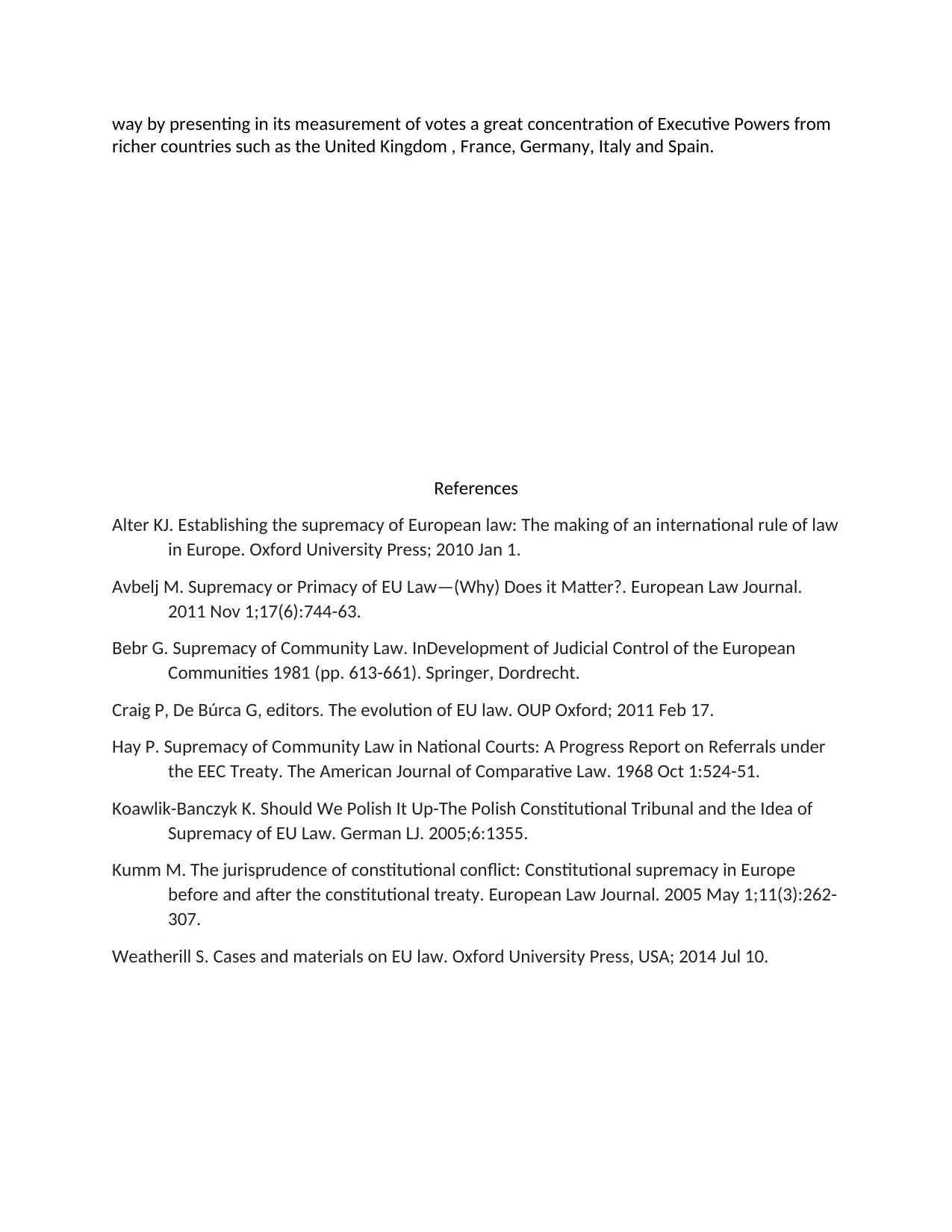
way by presenting in its measurement of votes a great concentration of Executive Powers from
richer countries such as the United Kingdom , France, Germany, Italy and Spain.
References
Alter KJ. Establishing the supremacy of European law: The making of an international rule of law
in Europe. Oxford University Press; 2010 Jan 1.
Avbelj M. Supremacy or Primacy of EU Law—(Why) Does it Matter?. European Law Journal.
2011 Nov 1;17(6):744-63.
Bebr G. Supremacy of Community Law. InDevelopment of Judicial Control of the European
Communities 1981 (pp. 613-661). Springer, Dordrecht.
Craig P, De Búrca G, editors. The evolution of EU law. OUP Oxford; 2011 Feb 17.
Hay P. Supremacy of Community Law in National Courts: A Progress Report on Referrals under
the EEC Treaty. The American Journal of Comparative Law. 1968 Oct 1:524-51.
Koawlik-Banczyk K. Should We Polish It Up-The Polish Constitutional Tribunal and the Idea of
Supremacy of EU Law. German LJ. 2005;6:1355.
Kumm M. The jurisprudence of constitutional conflict: Constitutional supremacy in Europe
before and after the constitutional treaty. European Law Journal. 2005 May 1;11(3):262-
307.
Weatherill S. Cases and materials on EU law. Oxford University Press, USA; 2014 Jul 10.
richer countries such as the United Kingdom , France, Germany, Italy and Spain.
References
Alter KJ. Establishing the supremacy of European law: The making of an international rule of law
in Europe. Oxford University Press; 2010 Jan 1.
Avbelj M. Supremacy or Primacy of EU Law—(Why) Does it Matter?. European Law Journal.
2011 Nov 1;17(6):744-63.
Bebr G. Supremacy of Community Law. InDevelopment of Judicial Control of the European
Communities 1981 (pp. 613-661). Springer, Dordrecht.
Craig P, De Búrca G, editors. The evolution of EU law. OUP Oxford; 2011 Feb 17.
Hay P. Supremacy of Community Law in National Courts: A Progress Report on Referrals under
the EEC Treaty. The American Journal of Comparative Law. 1968 Oct 1:524-51.
Koawlik-Banczyk K. Should We Polish It Up-The Polish Constitutional Tribunal and the Idea of
Supremacy of EU Law. German LJ. 2005;6:1355.
Kumm M. The jurisprudence of constitutional conflict: Constitutional supremacy in Europe
before and after the constitutional treaty. European Law Journal. 2005 May 1;11(3):262-
307.
Weatherill S. Cases and materials on EU law. Oxford University Press, USA; 2014 Jul 10.
1 out of 5
Related Documents
Your All-in-One AI-Powered Toolkit for Academic Success.
+13062052269
info@desklib.com
Available 24*7 on WhatsApp / Email
![[object Object]](/_next/static/media/star-bottom.7253800d.svg)
Unlock your academic potential
Copyright © 2020–2025 A2Z Services. All Rights Reserved. Developed and managed by ZUCOL.





